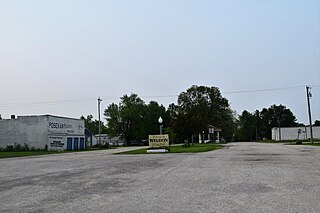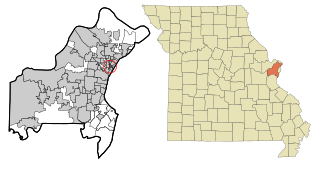
Schuyler County is a county located in the northeastern portion of the U.S. state of Missouri. As of the 2020 census, its population was 4,032, making it the fourth-least populous county in Missouri. Its county seat is Lancaster. The county was organized February 14, 1845, from Adair County, and named for General Philip Schuyler, delegate to the Continental Congress and U.S. Senator from New York.

Weldon is a city in Clarke and Decatur counties of the U.S. state of Iowa. The population was 136 at the time of the 2020 census.

Wheaton is a city in Wheaton Township, Barry County, Missouri, United States. The population was 696 at the 2010 census.

Hallsville is a city in Boone County, Missouri. It is part of the Columbia metropolitan area. The population was 1,614 at the time of the 2020 census. Southeast of the town is Mount Zion Church and Cemetery, the site of the Battle of Mount Zion Church during the Civil War.

Sturgeon is a city in Boone County, Missouri, United States. It is part of the Columbia, Missouri Metropolitan Statistical Area. The population was 872 at the 2010 census.

Linneus is a small city in Linn County, Missouri, United States. The population was 281 at the 2020 census. It is the county seat of Linn County.

Chamois is a city in Osage County, Missouri, United States. The population was 377 at the 2020 census. It is part of the Jefferson City, Missouri Metropolitan Statistical Area.

Livonia is a village in eastern Putnam County, Missouri, United States. The population was 52 at the 2020 census.

Worthington is a village in southeast Putnam County, Missouri, United States. The population was 47 at the 2020 census.

Lancaster is a city in Schuyler County, Missouri, United States. As of the 2020 census, its population was 675. It is the county seat of Schuyler County.

For the place nicknamed "the Queen City of the Ozarks", see Springfield, Missouri.

Shelbyville is a city in Shelby County, Missouri, United States. The population was 518 at the 2020 census. It is the county seat of Shelby County.

Greendale is a city in St. Louis County, Missouri, United States. The population was 651 at the 2010 census.

Velda City is a city in St. Louis County, Missouri, United States. The population was 1,420 at the 2010 census.

Green City is a city in northeast Sullivan County, Missouri, United States. The population was 657 at the 2010 census.

Greencastle is a city in eastern Sullivan County, Missouri, United States. The population was 224 at the 2020 census.

Holts Summit is a small city in Callaway County, Missouri. The population was 3,247 at the time of the 2010 census. Holts Summit is located 7 miles (11 km) northeast of Jefferson City, Missouri's state capital. It is part of the Jefferson City Metropolitan Area.

Berlin is a city in LaMoure County, North Dakota, United States. The population was 31 at the 2020 census. Berlin was founded in 1887.

Greentop is a city in Adair and Schuyler counties, Missouri, United States. As of the 2020 census, its population was 388.

Marceline is a city in Chariton and Linn counties in the U.S. state of Missouri. The population was 2,123 at the 2020 census.
























